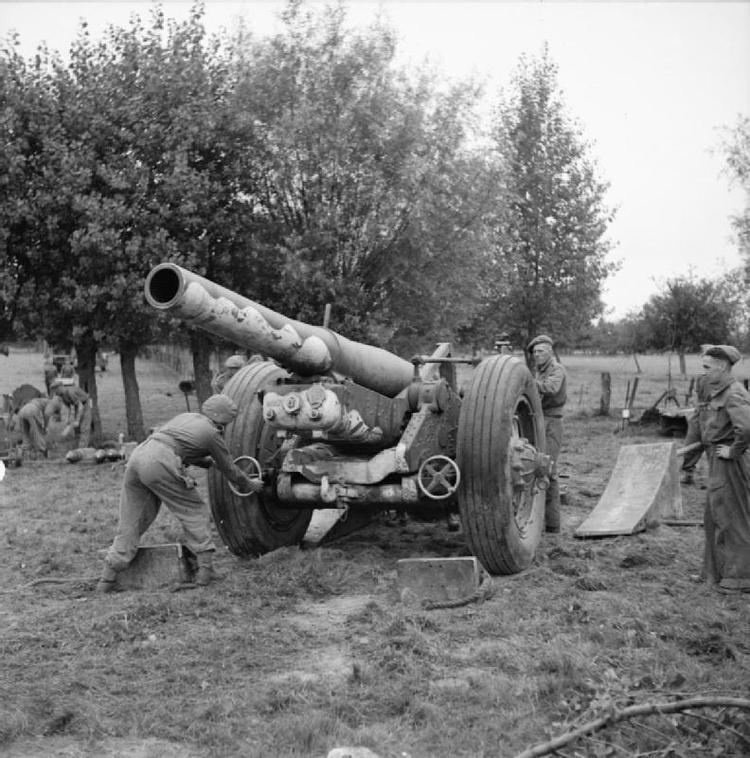Type Howitzer Weight 22,000 lb (10,000 kg) Width 9 ft (2.7 m) | Length 24 ft 4 in (7.42 m) | |
 | ||
Barrel length | ||
The BL 7.2-inch howitzer Mks I–V and Mk 6, were a series of heavy artillery pieces used by the British Army throughout World War II.
Contents
History
In 1940 the British Army concluded that the only available heavy artillery, the World War I era BL 8-inch howitzer, had insufficient range for the conditions of World War II. As a stopgap the decision was made to re-line the existing barrels to a smaller calibre and develop a new range of ammunition to achieve the desired ranges.
Marks I–IV
The 8 inch barrels were re-lined to 7.2 inches (180 mm) and the old carriages were retained although the original steel rimmed wheels were replaced with new pneumatic balloon-tyre wheels, as was consistent with the motorisation of the British Army. The new four-charge ammunition increased the range to 16,900 yd (15,500 m), but when fired at full charge the recoil caused the weapon to rear violently and jump backwards. To help counter this, two wedge shaped ramps were placed behind the wheels although the gun could sometimes still jump over them, presenting a hazard to crews. Marks I–IV differed only in the original 8-inch barrel used and the type of conversion; some barrels and carriages were also supplied from US World War I stocks.
Mark V
In 1944 several 7.2-inch barrels were placed in the US Carriage M1 used by the 155 mm Long Tom already in use by the British Army, becoming the BL 7.2-inch howitzer Mk V. Few Mk Vs were produced and it was never issued to batteries, as it was apparent that the Carriage M1 was capable of accepting greater recoil forces.
Mark 6
The BL 7.2-inch howitzer Mk 6 (there was a shift from Roman numerals) retained the Carriage M1 of the Mk V but had a new built 7.2 inch barrel 6 ft 5 in (1.96 m) longer than previous marks and a fifth charge was added to the ammunition. The longer barrel and extra charge provided a range increase to 19,667 yd (17,984 m). The new carriage also provided a far more stable platform, greatly increasing accuracy. The Mk 6 was considered a highly effective gun.
Use
The original marks performed well. The first 7.2-inch howitzers were issued to batteries from mid-1942 and used in action in North Africa and later following the Normandy landings. In Burma they were provided as a pool of two guns per corps and used by Regiments as required. By the end of 1944, most of the earlier marks had been replaced by the Mk 6.
The usual gun tractor for the 7.2-inch howitzer in the early war years was the Scammell Pioneer, although this was never available in sufficient numbers. From late 1943 the Pioneer was supplemented by the Albion CX22S.
The BL 7.2-inch howitzer formed parts of "Heavy" regiments of Army Group Royal Artillery (AGRA) units, providing heavy fire support for British and Commonwealth troops. The Mk 6 remained in British Army service until the early 1960s.
A modified version of the gun was used as the main armament of the experimental FV4005 Stage II tank, based on the centurion main battle tank, as well as the main armament of the experimental FV215b tank.
Operators
See: "7.2-Inch Howitzer". British Artillery in World War 2.
